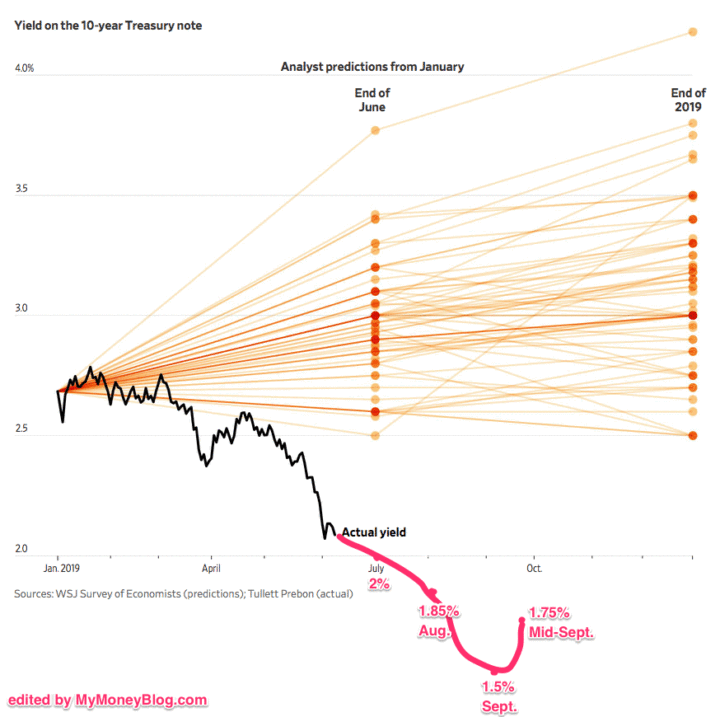 The financial prediction industry is simply mind-boggling to me. There is zero long-term memory or accountability. You can make all the predictions you want about the stock market, gold prices, and interest rates, and nobody remembers your bad calls. You get a contrarian call right, and all of a sudden you’re on all the TV interviews and news articles.
The financial prediction industry is simply mind-boggling to me. There is zero long-term memory or accountability. You can make all the predictions you want about the stock market, gold prices, and interest rates, and nobody remembers your bad calls. You get a contrarian call right, and all of a sudden you’re on all the TV interviews and news articles.
Allow me to remind you of what the Wall Street Journal’s panel of economists predicted in January 2019 as to what interest rates would look like the rest of the year (WSJ source). I have updated the chart with the current rates (click to enlarge). This was less than 10 months ago!
Apologies for the sloppy graphics, but you can see that 10-year rates dropped down to 2% in July, down even further to 1.5% at the beginning of September, with a slight bounce up to around 1.75% today. Not a single prediction was even close to reality.
When I was stocking up on 4% APY 5-year CDs last year, I was reading comments like “Why lock in such a low rate? You’re going to see much higher rates soon!”. Now, all of the comments are “You better lock in that 3% CD before rates drop further!”
Predicting interest rates even only as far as the next 12 months, is incredibly hard. You can’t do it reliably. Nobody can do it reliably. You might get it right, but that is called luck and not skill.
Individual investors don’t have an advantage in predicting future rates, but they do have their own set of special advantages. As an individual investor, you can purchase certificates from any FDIC-insured bank or NCUA-insured credit union if the interest rate is better than the comparable US Treasury. Over the last couple of years, I was able to buy multiple 5-year CDs at 4% APY when the 5-year Treasury was well below 3%. You have to act decisively, but any individual can do it. Pension funds and other institutional investors can’t.
I have a ladder of 5-year CDs. Each year, I buy a 5-year CD when a compelling interest rate arises. I don’t care about the rate direction, as long as I get about 1% above US Treasuries. After 5 years of doing this, you will have a ladder of CDs such that each year one CD is maturing and you can simply reinvest the funds each year. If I managed to put one year of expenses into each rung of this ladder, I now have 5 years of expenses in the bank, fully-insured and ready to go in case of financial emergency. An extra 1% on each $100,000 is $1,000 a year. That’s real money.
If this sounds like too much trouble to open accounts at multiple banks, you can always still with a Total US Bond fund (like AGG or BND). You’re essentially buying an ladder of bonds. BND has an average effective maturity of 8 years and average duration of 6 years. You might also buy it automatically inside a Vanguard Target Retirement Fund. Just keep buying it and ignore any talk about “The Fed”. Keep the chart above in your mind.

 The Best Credit Card Bonus Offers – 2025
The Best Credit Card Bonus Offers – 2025 Big List of Free Stocks from Brokerage Apps
Big List of Free Stocks from Brokerage Apps Best Interest Rates on Cash - 2025
Best Interest Rates on Cash - 2025 Free Credit Scores x 3 + Free Credit Monitoring
Free Credit Scores x 3 + Free Credit Monitoring Best No Fee 0% APR Balance Transfer Offers
Best No Fee 0% APR Balance Transfer Offers Little-Known Cellular Data Plans That Can Save Big Money
Little-Known Cellular Data Plans That Can Save Big Money How To Haggle Your Cable or Direct TV Bill
How To Haggle Your Cable or Direct TV Bill Big List of Free Consumer Data Reports (Credit, Rent, Work)
Big List of Free Consumer Data Reports (Credit, Rent, Work)
So there’s a bit of a fallacy here. Take a couple dozen “predictors,” chart some sort of scattergram, and get what you implicitly represent as a probability distribution for future rates. Then show how the predictors are foolish because the outcome was “off the charts.”
And now for the fallacy. Each “predictor” has in mind some mean and some sigma for the future rate. The scattergram presents those individual means while ignoring those individual sigmas. So of course it is going to show all of the predictors foolishly clumped together.
I’ve been buying EE bonds since 2015. Not because I’m a genius. Not because I anticipated this rout in interest rates or because I expect rates to continue to go lower. Simply because these securities have been a gift of long duration (6 years is not long duration, nor is a 5-year CD), full faith and credit of US, tax-deferred, state-tax-free income. And that type of investment should be part of any balanced portfolio. Not the entirety, not the majority, a part. Even if—in it’s most attractive form—it is illiquid.
With negative rates ubiquitous around the world, it is not shocking that US rates have declined. “Not shocking” is not the same as “normative” or “most likely.” So give the forecasters a break!
I don’t see the fallacy. Predictions were made, perhaps with uncertainties that aren’t shown. Either way, the means weren’t all that clustered, as there’s still some substantial variation between them (spread of 1.5%). And, the actual outcome turned out to be very far from even the nearest prediction.
If this were a scientific model, the scientists would need to seriously reevaluate things. But it isn’t, and so (I believe to Jonathon’s point), they can just go on and try again and again.
Why do the forecasters need to be given a break? Maybe it’s better to wonder what the point of making the forecast is. If someone took them seriously, they may have suffered real consequences.
Just that each predictor was asked for an expectation, which is a mean value. Had each predictor been asked about the probability of further rate declines, that may have resulted in a substantial number. As investors for (say) retirement, we are interested less in the average outcome and more in where the risks are.
Having said that, I do hope my tone wasn’t too critical. I really like Jonathan’s blog and have gotten a lot of good ideas here over the years. I do think he tends to underestimate the need for duration in a bond portfolio, relying too much on stocks and shorter-term fixed income securities that are essentially cash proxies.
Thanks for sharing Jonathan. I have been laddering for years and prefer cash over bonds as my fixed income portion of my portfolio. I was able to lock up @3.5% for 5 years.
Just curious who had 4%?
Sharonview 4% in March 2018
Garden Savings 4% in November 2018
In July 2019, I got the 5-year NavyFed CD at 3.50% APY
Thanks!! Yep Navy and Connexus is where I parked some cash.
Have to hand it to the Credit Unions!!:)
Looks like interest rates are heading toward Alabama. MMB is having its own Sharpie-gate!
I can make an accurate prediction on when rates are going to go up again: Never.
I’d suggest your readers consider watching Mark Spitznagel’s Bloomberg interview from 2015 which like most prophecies can be both painful and enlightening.
https://www.bloomberg.com/news/videos/2015-05-13/meet-the-investor-hungry-for-a-bull-market-correction
Mr Ping:
Exactly the same thing applies to predictors of the securities market. If I had taken their advice each time they tell me get out or get in, I would be much poorer. I use Buffett’s strategy: https://www.amazon.com/Warren-Buffett-Your-Investment-Advisor/dp/1518690963.
I believe Peter Schiff was fairly accurate in his interest rate call, maybe one of the few.
There’s a classic joke on this topic. God is wandering around Heaven one day. He stops someone and asks “What’s your name?” The man answers “Albert Einstein.” God asks “What’s your IQ?” The man answers “About 180.” God says “Great! Let’s talk about quantum mechanics.” They talk for a while, then God leaves, goes up to someone else and says “What’s your name?” The woman replies “Joanne Thompson.” God says “What’s your IQ?” She answers “About 125.” God says “Great! Let’s talk about political systems on Earth.” They talk for a while, then God leaves, goes up to someone else, and says “What’s your name?” The guy thinks for a while, and finally says “Joe.” God says “What’s your IQ?” The guy thinks some more, and finally says “60, I think.” God says “Great! Let’s talk about the future of interest rates.”